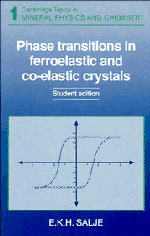Book contents
- Frontmatter
- Contents
- Errata
- Preface
- A brief guide for the reader
- 1 Introduction and some definitions
- 2 Ferroelastic and co-elastic phase transition
- 3 The Landau potential
- 4 The spontaneous strain
- 5 Coupling between the spontaneous strain and the order parameter
- 6 Macroscopic classification of ferroic and co-elastic crystals
- 7 Ferroelastic and co-elastic twin structures
- 8 Domain mobilities and elastic instabilities in ferroelastic and co-elastic materials
- 9 Specific heat anomalies and the excess entropy
- 10 Coupling between order parameters in ferroelastic and co-elastic crystals
- 11 Gradient coupling and strain modulations
- 12 Some aspects of the kinetic behaviour of ferroelastic and co-elastic crystals: an outlook
- References
- Appendix: An atomistic model for the Landau potential and the origins of the saturation effect
- Index
7 - Ferroelastic and co-elastic twin structures
Published online by Cambridge University Press: 03 May 2011
- Frontmatter
- Contents
- Errata
- Preface
- A brief guide for the reader
- 1 Introduction and some definitions
- 2 Ferroelastic and co-elastic phase transition
- 3 The Landau potential
- 4 The spontaneous strain
- 5 Coupling between the spontaneous strain and the order parameter
- 6 Macroscopic classification of ferroic and co-elastic crystals
- 7 Ferroelastic and co-elastic twin structures
- 8 Domain mobilities and elastic instabilities in ferroelastic and co-elastic materials
- 9 Specific heat anomalies and the excess entropy
- 10 Coupling between order parameters in ferroelastic and co-elastic crystals
- 11 Gradient coupling and strain modulations
- 12 Some aspects of the kinetic behaviour of ferroelastic and co-elastic crystals: an outlook
- References
- Appendix: An atomistic model for the Landau potential and the origins of the saturation effect
- Index
Summary
The static twin structures are explained here: which twins occur and how they interact. The major microstructures are: rounded junctions where twins intersect, S-shaped walls, and needle twins. Phenomenological description and theory are separated in these chapters. If the reader is only interested in the descriptive part, he or she can ignore 7.1, 7.2b, 7.3b and 7.4b. To help the reader, a summary of the main ideas discussed, is provided at the end of each theoretical section.
Twins in minerals are formed by several mechanisms, which according to Burger (1945), can be classified into growth, transformation and gliding. In the absence of external fields, as described in the last chapter, transformation twins are entirely due to the generation of the spontaneous strain during a co-elastic phase transition. Their geometrical and physical properties then follow directly from the temperature evolution of the spontaneous strain and we shall develop a concept which allows us to identify the essential features of twin boundaries on a length scale which is still rather unaffected by direct structural properties (i.e. we shall use the continuum approximation on a mesoscopic length scale). In this Chapter we shall treat such twin structures as a static phenomenon, expected to occur at temperatures not too close to the transition point. Some aspects of the dynamics of the domain structure are explored in Chapter 8.
It is rather useful at the beginning of the discussion of twin structures and their dynamics to recall the surprisingly large strain and stress fields which exist in a co-elastic material.
- Type
- Chapter
- Information
- Publisher: Cambridge University PressPrint publication year: 1991
- 1
- Cited by



